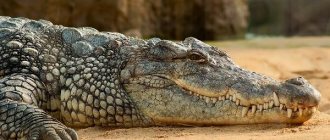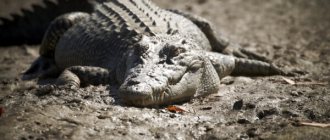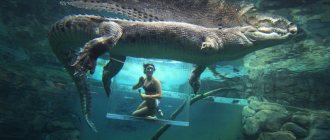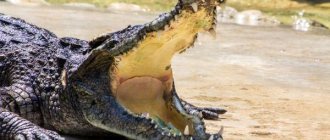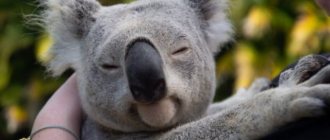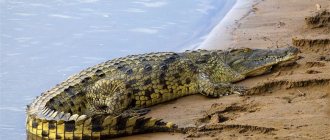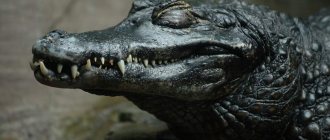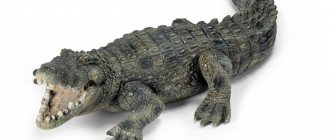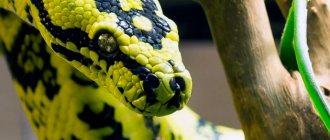Saltwater crocodile: description
Saltwater crocodiles represent reptiles that belong to the order Crocodiles, the family and genus of true crocodiles, and also to a separate species - saltwater crocodiles. Experts suggest that such ancient inhabitants of our Planet descended from crocodiles.
These reptiles lived within the continent of Gondwana already approximately 100 million years ago. The strange thing is that they survived the Cretaceous-Paleogene extinction. The remains of these ancient reptiles have been found west of Queensland. According to some information, in the past there was a sea in these territories. Based on the skeletal remains, it was established that the reptile could make rapid rotations around its axis.
Despite this, experts cannot say for certain exactly in what period saltwater crocodiles appeared on our Planet as a separate species. Scientists know that about 5 million years ago this species already existed. External features suggest that saltwater crocodiles are similar to Philippine, New Guinea and Australian crocodiles, although genetic studies indicate their similarities to Asian crocodiles.
The saltwater crocodile is a monster that eats whales and tigers! Crocodile vs shark and wild boar!
Appearance and features
This reptile is characterized by a terrifying appearance, with the length of adult individuals reaching up to 6 meters and their weight being about 900 kilograms.
Interesting to know! The head of some adult males can weigh about 200 kilograms. Males and females differ in their sizes, so females weigh half as much, and their length is also about half as long.
The body of the reptile is flat, but voluminous, and it smoothly transitions into the tail. The length of the tail is usually more than half the length of the body. The massive body is supported by relatively short but powerful limbs. Because of this, saltwater crocodiles were part of the alligator family for a long period of time. As a result of modern research, this species has been classified as a member of the family of true crocodiles.
The crocodile has an elongated muzzle, with huge and powerful jaws, which are armed with more than 6 dozen sharp teeth, and the strength of these jaws is simply incredible. If a crocodile closes its jaws, no one can open them. The eyes are relatively small, located high, with ridges located in two rows between them towards the tip of the nose.
The back area, as well as the abdominal area, is covered with scales that do not ossify as the reptile ages, compared to other types of crocodiles. The main body color of the crocodile is brown or dark green, with an olive tint. This color is camouflage, since the crocodile is practically invisible when in ambush. Juveniles differ somewhat in the color of their body, as their color is lighter, almost yellowish, with spots and stripes scattered throughout the body.
Around the 10th year of its life, the reptile’s color becomes darker, and spots and stripes cease to stand out on the body, but they do not completely disappear. The lower part of the body is lighter, as are the limbs, almost yellow. The lower part of the tail is gray, with dark stripes.
This reptile has excellent vision, so the crocodile sees perfectly both in water and on land. Once in the water, the eyes are closed with a special partition. It should be noted that the reptile also has fine hearing, so it picks up the slightest rustle. The crocodile has special glands, thanks to which the reptile gets rid of excess salt in its body. It follows from this that this species of crocodiles is capable of living not only in fresh water bodies, but also in salt water bodies.
Where does the saltwater crocodile live?
If previously saltwater crocodiles lived in vast territories, in our time the habitat of this reptile has narrowed significantly.
Saltwater crocodiles are found:
- On the territory of Indonesia.
- On the territory of Vietnam.
- In the east of India.
- In New Guinea.
- On the Australian continent.
- In the Philippines.
- Within Southeast Asia.
- In Japan, but in small quantities.
The most numerous populations of saltwater crocodiles live within the Indian and Pacific Oceans, as well as in northern Australia. This type of crocodiles is characterized by the fact that they can travel vast distances through water. Some individuals appear in the open ocean, where they can remain for a long time. Males are able to travel about one thousand kilometers, and females are half that size. They do well in small bodies of water, both fresh and salt water.
The ideal habitats for combed crocodiles are considered to be quiet, calm, but deep bodies of water bordering savannas and flat areas where the vegetation is quite dense. They are also found along sea coasts, as well as in river mouths. Once in open sea waters, crocodiles mostly swim with the current to save energy.
Interesting moment! Basically, populations of saltwater crocodiles are concentrated in warm climates, including in small bodies of water, as well as in swampy areas. When the dry season sets in, crocodiles move downstream and appear in river mouths.
What does a saltwater crocodile eat?
Saltwater crocodiles are quite strong and dangerous predators that are at the top of the food chain. The basis of the diet consists of food items of animal origin, of which the predator needs quite a lot. The most important thing is that the predator feeds exclusively on fresh meat, although in case of severe hunger it can eat carrion. Juveniles and females feed on various types of large insects, as well as small invertebrates. Young, and even more so adult males require slightly larger food items.
The diet of saltwater crocodiles consists of:
- From wildebeest antelope.
- From African buffalo.
- From turtles.
- From boars.
- From sharks and large fish.
- From deer.
- From tapirs.
- From kangaroo.
- From leopards.
- From bears.
- From pythons.
Saltwater crocodiles are considered to be terribly bloodthirsty predators living on our Planet. They prefer to eat everything that ends up in their mouths, including people, as well as their younger and weaker counterparts. They are considered quite skilled hunters, since they can stay in their shelters for a long time, waiting for their prey.
If the prey is within reach, the crocodile instantly pounces on it, closing its jaws. They may not kill their prey, but try to tear off fragments from it, rotating around their axis. At one time, a crocodile can swallow a fragment of its victim equal to half its body weight.
If you look at the body of a crocodile, you get the impression that this reptile is moving slowly. In fact, this is not the case, since this predator easily overcomes various obstacles and also conquers steep cliffs while pursuing its prey. Once in the water, the predator swims at speeds of up to 35 km/h.
Most of the processed food turns into fat deposits, which helps the predator easily survive periods when the hunt is unsuccessful. Reserves of adipose tissue allow the reptile to starve for a long period of time. Along with food, the crocodile swallows stones, which help digest food, which the crocodile swallows whole without chewing.
Even salty sea water is not afraid of him - THE GRAVE CROCODILE IN ACTION
Character and lifestyle
Saltwater crocodiles are considered the most powerful, cunning and bloodthirsty predators that have no competitors in the wild. They can live in both salt and fresh water, and in search of food they can travel significant distances along the water surface. They swim far into the ocean, remaining there for a long time. The reptile is helped in this by a relatively long and strong tail, which serves both as a propeller and as a rudder.
Important point! Living within rivers, these reptiles prefer to stick to certain territories. As a rule, they live separately, although they are also found in groups.
Saltwater crocodiles feel uncomfortable at elevated temperatures, so they prefer to wait out the daytime heat in the water column. If the ambient temperature drops to a certain point, reptiles look for warm places heated by the sun to warm up their bodies. These predators communicate with each other using a set of specific sounds. Representatives of their genus may be aggressive either during the breeding season or when defending their territory. Such fights are particularly cruel, so it is not surprising that they often end in death.
A group of reptiles or individual individuals control a certain territory, protecting it from the encroachments of other individuals. Generally, males control a territory, which includes several female-controlled territories, as well as a breeding territory. Males show particular aggression towards males, but at the same time they are favorable towards females and often share their prey with them.
These reptiles are not afraid of humans, and they rarely attack humans, unless there is a lack of food. In addition, a saltwater crocodile can attack a person if the person is careless and also threatens small crocodiles or eggs.
How long does a saltwater crocodile live?
Animals of this species live a very long time: their minimum life expectancy is 65-70 years, but scientists do not exclude the possibility that these reptiles can live up to 100 years or even more. In captivity, individuals of this species live a little over 50 years.
Reproduction and offspring
Starting from November and ending at the end of March, these reptiles have a breeding season. During this period, reptiles prefer to live in fresh water conditions. Very often you can see males getting into fights over the right to own a certain territory. Males create harems, which include up to a dozen females, or even more.
The female is busy building a nest, which reaches a length of at least 8 meters and a width of about one meter. The nest is located on a hill so that it is not destroyed by rain. The female lays from two dozen to almost one hundred eggs in the nest.
Having laid eggs, the female tries to camouflage them with the help of green vegetation and leaves. After three months have passed, a faint squeak begins to be heard from the eggs. The female, hearing these sounds, rushes to the aid of her offspring. The female helps the small crocodiles free themselves from their shells. Throughout the entire period of embryo development, the female remains close to the nest, protecting her clutch.
Small crocodiles are born, weighing no more than one hundred grams. Despite this, the offspring grow very quickly, become stronger and gain weight. The female takes care of her offspring for 6-7 months. Despite the fact that the offspring are constantly close to their mother, only one percent survive. Mostly young individuals die from encounters with older young crocodiles, as well as from older crocodiles.
When the temperature in the nest is about 31.5 degrees, mostly males are born. This temperature is achieved as a result of rotting vegetation that is in the nest. If the temperature in the nest is slightly lower or slightly higher, mostly females are born. Females are ready to reproduce after reaching 10-12 years, and males after reaching 15-16 years.
It is important to know! Females are ready to breed after their body length reaches a little more than two meters, and males when their body length reaches a little more than 3 meters. Saltwater crocodiles live for about seven decades, with some individuals living up to a hundred years, and sometimes longer.
Natural enemies
Living in the natural environment, saltwater crocodiles as adults have virtually no natural enemies, but when they swim far into open waters, they can become dinner for large sharks. The main enemy is considered to be man. Due to the activities of poachers, this species of reptile is on the verge of complete extinction. Young, inexperienced individuals are attacked by other predators, and some predators also destroy egg clutches.
The following predators destroy nests and attack young individuals:
- Monitor lizards.
- Big turtles.
- Herons.
- Crows.
- Hawks.
- Some types of cats.
- Large predatory fish.
Tiger snake
It lives in Australia, on the island of Tasmania and New Guinea. It feeds on lizards, snakes, various amphibians, insects and small mammals. It is one of the most poisonous land snakes. Small animals bitten by a tiger snake die almost instantly. Its poison also poses a real threat to human life. Fortunately, the snake is not aggressive and is extremely lazy.
Population and species status
In the late 80s and early 90s, the number of saltwater crocodiles reached a critical level. Reptiles were mainly exterminated in order to obtain valuable skin, making expensive household items from it. Saltwater crocodiles have been listed as critically endangered in the International Red Book. In the habitats of saltwater crocodiles, hunting them is prohibited by law. In countries where saltwater crocodiles live, not only the skin of the reptile is valued, but also its meat, from which various delicacies are prepared.
Population numbers are also affected by human destruction of the saltwater crocodile's natural habitat. In some countries where saltwater crocodiles were previously found in large numbers, today this species is not found at all. Such countries include Thailand and Sri Lanka, and only a few specimens remain within Japan. In the south of Vietnam, there were previously thousands of individuals of these reptiles, and then their numbers decreased to only a few hundred individuals. Nowadays, about 200 thousand individuals of saltwater crocodiles live in Vietnam. Although the saltwater crocodile is now classified as a rare species, it is not on the verge of extinction as a species.
Coastal taipan
This is the most poisonous and largest snake in Australia. Its length can reach 2.3 m. It feeds on frogs and small mammals, including mice and rats. The coastal taipan is very aggressive. In case of danger, it curls up into a ring and vibrates the end of its tail. Unlike other snakes, which, having bitten the victim, crawl away, the taipan stings several times. And he does it so quickly that the victims don’t even have time to react. A person bitten by a taipan can die in just a few hours.
The structure of the mouth of a poisonous snake: A, B - poisonous teeth, C - poisonous canal, D - poisonous gland, D - glottis
Conservation of saltwater crocodiles
As mentioned earlier, saltwater crocodiles are listed in the International Red Book in order to make efforts to preserve this species of reptile. In addition, saltwater crocodiles are listed in Appendix I of the CITES Convention. IN some countries, efforts made to increase the number of saltwater crocodiles have not brought the desired result.
In India, they decided to take special steps to prevent the extinction of this predator. For this purpose, crocodiles are specially bred within the Bhitarkinaka National Reserve. As a result of such efforts, about one and a half thousand individuals were released into the wild in the park; only a third of them survived.
Important point! About one thousand individuals live in India, while the number of crocodiles is at a stable level.
The most numerous populations of these reptiles live on the Australian continent. There are restrictive measures aimed at preserving and enhancing the species. Hunting for these reptiles is prohibited here, while environmental organizations carry out educational work among the population, reminding that violation of the laws will result in criminal liability. In addition, in Australia, these reptiles are artificially bred on the territory of special farms, as well as national parks.
Despite the fact that saltwater crocodiles are considered the most dangerous species of predators, they occupy their niche by ensuring the balance of the ecosystem on our Planet. In addition, combed crocodiles are considered the most ancient inhabitants of wildlife. Thanks to human activities, this species is on the verge of extinction. Nowadays, thanks to the efforts of the same person, in some areas the number of this species remains at a stable level, so we can safely say that in the near future we should not expect this species to disappear from the face of the earth.
Unique "trophy"
And then one day the Pawlowski couple and their children went to the Norman River in search of their next prey. This was in July 1955. Suddenly, a gigantic crocodile emerged from the pond and headed towards their three-year-old daughter Barbara. Without thinking twice, Christina took the rifle and killed the reptile with one shot. Death was instantaneous, as the bullet hit him under the right eye, which led to cardiac arrest. At that time, Christina was still a novice crocodile hunter: she killed three reptiles.
Emigration to the USA and an unsuccessful marriage: how the life of the beauty Natalia Lapina turned out
To avoid harm to health: choose frying oil with a high smoke point
Dresses of Maria Feodorovna and more: The Hermitage made a gift to the Historical Museum
The couple did not throw away the huge carcass, but immediately skinned it and then sold it for thirteen pounds. At that time it was good money. Son George recalls that you could live comfortably for a week on ten pounds.
Spectacled caiman, 2 m
Its other name is crocodile caiman . It has a long muzzle, tapering at the front. It can be of different lengths, but most males are from 1.8 to 2 m in length, and females do not exceed 1.2 -1.4 m, they weigh from 7 to 40 kg. The largest spectacled caiman is 2.2 m, and the female is 1.61 m.
Juveniles are yellow in color and covered with black spots and stripes, while adults are usually olive in color. Crocodile caimans are found in Brazil, Bolivia, Mexico, etc. It lives in damp lowlands, near bodies of water, choosing standing water.
Young caimans often hide in floating islands and can be carried over long distances with them. When there is a period of drought, they burrow into the mud and hibernate. They feed on mollusks, crabs and fish. They are hunted by jaguars, anacondas and other crocodiles.
Cuvier's smooth-faced caiman, 1.6 m
Males of Cuvier's smooth-faced caiman do not exceed 210 cm, and females do not grow more than 150 cm. Most representatives of this species are no larger than 1.6 m and weigh about 20 kg. They can be found in South America.
For life, they choose shallow water areas where the current is quite fast, but they can also get used to standing water. They are also found in flooded forests.
Mertens' monitor
This species of lizard of the monitor lizard family lives in rocky gorges along rivers, near reservoirs, swamps and lagoons. Its body can reach a length of 160 cm. The Mertens monitor spends most of its time in the water, rarely moving a few meters away from it. When in danger, it dives under water and can remain there for quite a long time. An important adaptation of the Mertens monitor to a semi-aquatic lifestyle is its ability to remain active at low body temperatures.
Broad-faced caiman, 2 m
It is also called the broadnose caiman . It lives in Brazil, Bolivia, Paraguay, and Argentina. He has a wide muzzle and is olive in color. Males are slightly larger than females, their average size is two meters, but some individuals grow up to 3.5 m. Females are even smaller, their maximum length is 2 m.
The broad-faced caiman leads an aquatic lifestyle, loves mangrove swamps, and can settle close to human habitation. Eats water snails, fish, amphibians; adult males sometimes hunt capybaras. Their jaws are so powerful that they can bite through a turtle's shell.
They prefer to be nocturnal. They hide in the water, almost completely immerse themselves in it, leaving only their eyes and nostrils on the surface. They prefer to swallow prey whole rather than tear it into pieces.
In the 40-50s of the last century, many people hunted them, because... Their skin was highly prized, causing their numbers to decline. Forests are also being polluted and cut down, and plantations are expanding. Now it is a protected species.

